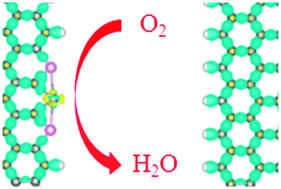Theoretical insights on the catalytic activity and mechanism for oxygen reduction reaction at Fe and P codoped graphene†
Abstract
The non-precious metal graphene catalyst doped with Fe–Px are recently proposed as a promising candidate in substituting Pt for catalyzing oxygen reduction reaction (ORR) in fuel cells. Systematic DFT calculations are performed to investigate the catalytic activity and the ORR mechanism on the Fe–Px (x = 1–4) system in acid medium in this work. Our results indicated that the configuration with one Fe and two P atoms codoped at zigzag edge site (Fe–P2–zig-G) is the most stable, in excellent agreement with the experimental observation that the ratio of Fe and P is nearly 1 : 2. The four-electron reduction mechanism for ORR on the Fe–P2–zig-G is via the competing OOH hydrogenation pathways (to form either OH + OH or O + H2O). The rate determining step is the O2 hydrogenation with an energy barrier of 0.43 eV, much smaller that of calculated 0.80 eV for pure Pt. In addition, the highest energy barrier of the studied ORR mechanism is the O2 dissociation with an energy barrier of 0.70 eV, a value also smaller than that of pure Pt. This demonstrated that the zigzag edge site of the Fe–P2 codoped graphene should be active for the ORR.


 Please wait while we load your content...
Please wait while we load your content...